An introduction to mining permits & what is tenure?
Published 25-AUG-2023 13:07 P.M.
|
10 minute read
Permitting is one of the most important aspects to any resources project.
Without a permit, a project can never be developed.
As an investor, it's important to understand what permits and agreements exist over a project to protect it from external disruption and delays.
The rights that these permits confer are also known as “tenure”.
Tenure basically means the rights that a company has over a piece of land.
We will have a close look at tenure in this educational article, and the different types of permits that companies need to get to be able to explore for resources.
But first, here is a table of the key permits that exist in Australia for mining and oil & gas companies at the exploration stage:
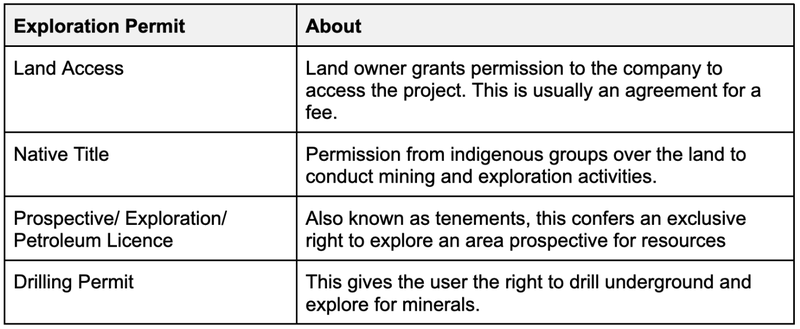
There are many sub-layers of permits that fit within these categories, but this list gives a general overview of the permits for exploration projects.
At the development stage of the project, when the company is looking to take its resource and turn it into a mine, there are also a bunch of permits needed.
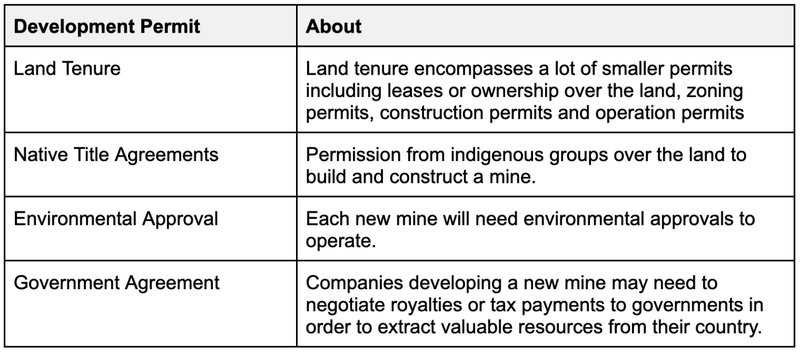
At the development stage, permitting is a big deal, as investors looking to finance expensive mining projects won’t write big checks until the permits are all in place.
Permitting can be boring for investors, and sometimes take years to secure - but without it, the project cannot go ahead.
On that note, let’s look at the fundamental concept that underpins the legal right to explore and develop mining projects, also known as tenure.
What is a tenure?
Tenure basically means the rights that a company has over a piece of land.
When investing in a company, “security of tenure” is an important risk factor that we consider as part of our due diligence process.
Security of tenure essentially asks: How secure are the land rights of the company?
Is the company’s exploration licence registered in a tier-1 jurisdiction, like Australia? OR does the company have a handshake agreement with the unnamed project vendor in Africa?
The first scenario has a very strong security of tenure, the second one, not so much.
Land rights are like a big layered cake, there are lots of parties involved, with different interests.
In order to secure the necessary agreements and permits companies will need to carefully navigate each of the parties with an interest in the land.
Here is what the land rights pyramid looks like in Australia.
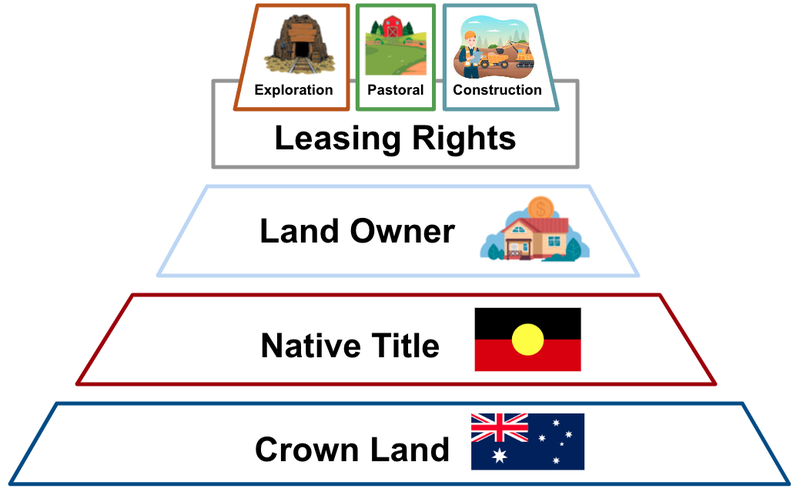
Tenure is the backbone that gives investors, off-takers, governments and companies the confidence to spend large amounts of capital developing mining and oil & gas projects.
...and the confidence that the project won’t be nationalised or taken by a third party.
A handshake agreement with an unknown party in Africa would not give confidence for investors to fund the project, but a registered licence that is backed by the Australian government does.
What is a Tenement?
The first licence that a company will get is likely to be an exploration licence, also known as a tenement.
A tenement grants the company an exclusive licence to explore for minerals in a particular area.
Securing tenaments can be done through registering the land with the relevant authority, or buying the registration from another company or party.
Securing a tenement is also known as “pegging ground”.
This is what a tenement looks like, the square boxes represent the tenements over the land:
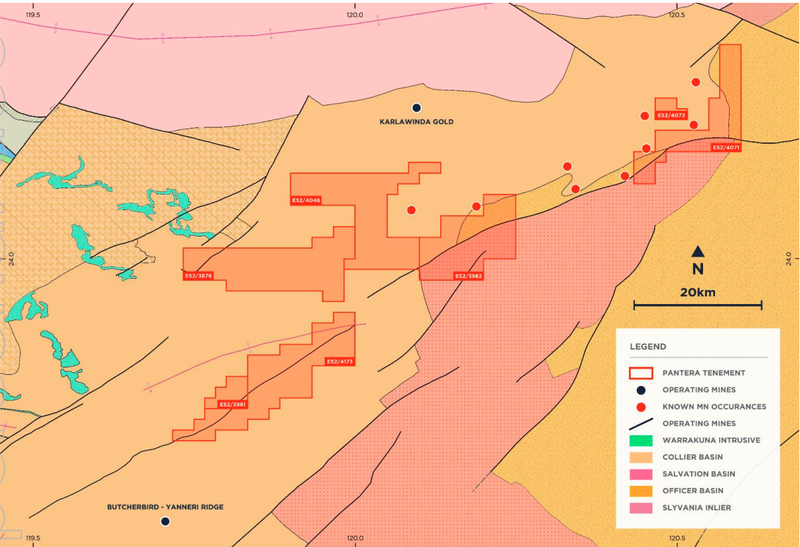
Tenements close to existing mineral discoveries with the same geology as the area of the discovery are considered valuable prospecting opportunities given the “nearology”.
🎓To learn more, read: How to evaluate “nearology” investments.
Tenements don’t last forever.
There is an annual cost that the company will need to pay to maintain the tenement, and in some jurisdictions, the company will need to spend a certain amount of dollars exploring over the tenement area to stop it from lapsing.
This prevents companies from sitting on the tenement forever and preventing exploration.
For ASX-listed companies, you can see a Tenement Schedule at the back of the quarterly report.
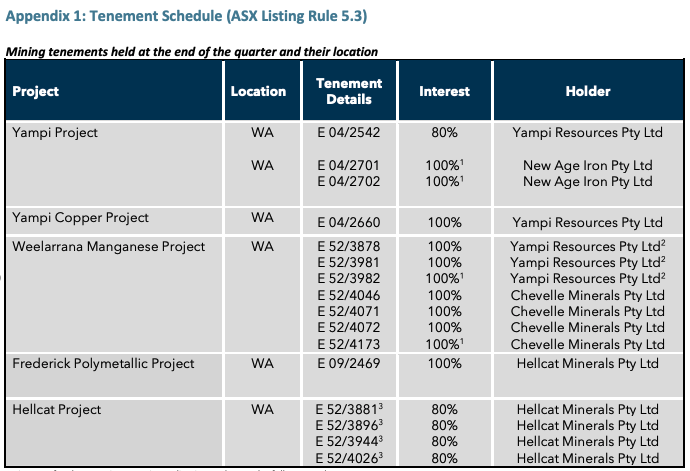
Pay attention to these as some of the tenements may lapse for projects that the company no longer sees value in.
By tracking changes in company’s tenement registers investors can also start to understand where the management team is looking to focus some exploration efforts in the future.
Land access agreement
Tenements secured, now it's time to explore.
The company will likely want to do some fieldwork and geophysics to help narrow down the areas of interest to drill, BUT it first needs permission from the land owner to access their private property.
To do this, the company will secure a “land access agreement”, which is generally for a nominal payment to the land owner in exchange for access to the land.
Native title agreements
If the tenement exists over a piece of land that is considered native title land, the company will need to first get the permission from the traditional owners to explore.
These native title agreements can take time, and are an important feature of the exploration process.
The company may need to pay a native title royalty on any minerals discovered in order to secure the agreements.
Drilling Permit
Once the tenement, land access and native title is granted, then the company will have all of the parts to set up for a drill campaign.
Before the company can drill however it will need to secure a drilling permit.
This is true for each new drilling campaign that the company will want to undertake over a project area (if the first permit did not cover this area of drilling).
There are two key aspects to this permit: Heritage Surveys and Environmental Surveys.
Heritage Surveys
Heritage surveys are conducted by qualified indigenous heritage consultants that survey the land for important indigenous artefacts or sites.
If the area is clear of any issues then the company can secure the heritage agreement to drill.
It’s important to note that heritage surveys can delay projects.
Heritage surveys can be booked out months in advance and if it rains heavily on the day the company has booked, the company will need to reschedule and delay the drilling.
Environmental Surveys
Before drilling the company may need to conduct some environmental surveys to ensure that the drilling won't disturb natural habitats.
When you see the phrase “walk up drill target” in an announcement, it means that the company likely doesn't need to clear any trees from the land and therefore environmental issues are far less likely.
Both environmental surveys and heritage agreements are not difficult permits to secure, but do cost money and can delay projects if they are not expedited.
Development Permits
Once the company has discovered a resource, defined its size and undertaken a feasibility study it will move to the “development stage” of the mining company life cycle:
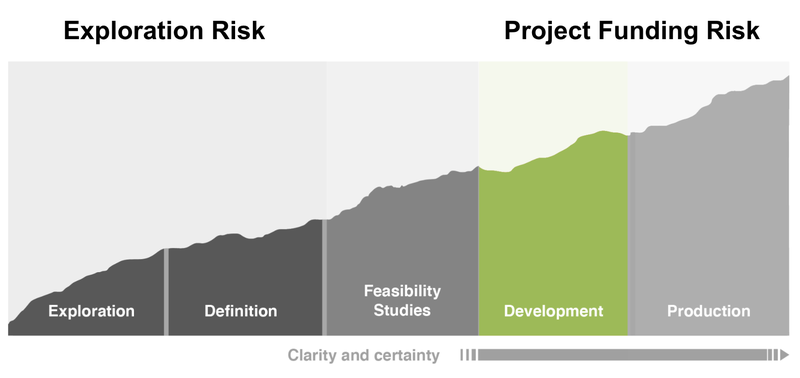
In this stage the company has one goal: Secure project funding to build the mine and move into production.
This is the most difficult part of any development stage mining project - convincing banks and institutional investors to provide the capital needed to develop the mine.
Institutional investors are conservative by nature.
They want to make sure that their capital is allocated to projects that have the best chance of financial return, and all key risks have been mitigated.
This means that the company will need to get all of the agreements and licences over the project to secure tenure for the project.
The key licences that the company will need at the development stage are:

Land Tenure
When a company is developing a mine or a project it will need to secure a site for mining and production.
There will need to be appropriate zoning over the site and the company will need to buy the land outright OR lease the land for a long period of time (for the life of the mine).
The company may also need to secure construction and operational permits from the government.
Generally, the company will have a land tenure plan outlined in its feasibility study, and investors can see what permits have been secured and which are still pending.
Native Title Permits
The company may need to negotiate with native title owners to secure an indigenous land use agreement for the production site.
The native title permission may cover the area over the mining resource, but if the processing site is in a different area the company may need to get further native title agreements over that new area of land.
Environmental approvals
There are also environmental approvals that the company will need to secure before moving into production.
These approvals all stem from an Environmental Impact Assessment that the company will undertake to evaluate the external impact of its project to the environment.
The EIA is a long process, and the results of which are a meaningful step towards securing environmental approvals for the mine.
Government production approvals
In some countries, there may be an agreement between the company and the government to share in the revenue generated by the project.
This agreement has many names including production sharing agreement, framework agreement or mining convention - but at its core it is the same thing.
It is an agreement between the company and the governement that outlines the royalty or tax in exchange for mining the valuable natural resources of the country.
Natural resources are seen by governments as a vital part of a country's income and companies may need to give up some of the project in order to secure the permits needed by the government.
When permitting goes wrong
Permitting can, and does go wrong.
It can be devastating for companies to have a mining permit, only for the government to cancel that licence and keep the project for themselves (or worse, give it to another company).
Permits can get delayed, or never granted - as the country’s affinity for mining or oil and gas projects change.
This is why it is important to understand the risks of the country that the permits are granted.
Here is the global risk map by Atradius:
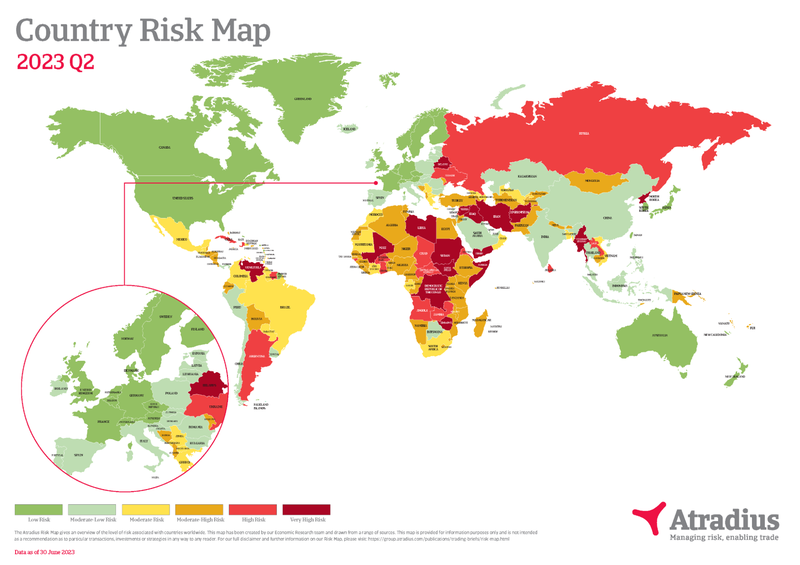
(Source)
Governments can and do change, and what was once a friendly government to mineral projects, may now want to nationalise the assets for the good of the country or move away from projects that were once harmful to the environment.
Nationalising mining projects can happen in countries where legal frameworks have not been well established, like in some countries in Africa - and it is a risk that investors need to be aware of.
Conclusions: Why permitting is important
Without a permit, a project is nothing but an idea.
Permits provide the necessary tenure over a project that gives investors the confidence to make large capital investments in mining projects.
Without them, projects can never be developed.
Permitting is one of the major reasons for project delays, and it can take up to years before key permits are secured by companies.
The more established the legal framework of the country the company is operating the stronger the tenure in the eyes of investors.
Key an eye on the project tenure when evaluating the risk of the project to make it through exploration and development.
General Information Only
S3 Consortium Pty Ltd (S3, ‘we’, ‘us’, ‘our’) (CAR No. 433913) is a corporate authorised representative of LeMessurier Securities Pty Ltd (AFSL No. 296877). The information contained in this article is general information and is for informational purposes only. Any advice is general advice only. Any advice contained in this article does not constitute personal advice and S3 has not taken into consideration your personal objectives, financial situation or needs. Please seek your own independent professional advice before making any financial investment decision. Those persons acting upon information contained in this article do so entirely at their own risk.
Conflicts of Interest Notice
S3 and its associated entities may hold investments in companies featured in its articles, including through being paid in the securities of the companies we provide commentary on. We disclose the securities held in relation to a particular company that we provide commentary on. Refer to our Disclosure Policy for information on our self-imposed trading blackouts, hold conditions and de-risking (sell conditions) which seek to mitigate against any potential conflicts of interest.
Publication Notice and Disclaimer
The information contained in this article is current as at the publication date. At the time of publishing, the information contained in this article is based on sources which are available in the public domain that we consider to be reliable, and our own analysis of those sources. The views of the author may not reflect the views of the AFSL holder. Any decision by you to purchase securities in the companies featured in this article should be done so after you have sought your own independent professional advice regarding this information and made your own inquiries as to the validity of any information in this article.
Any forward-looking statements contained in this article are not guarantees or predictions of future performance, and involve known and unknown risks, uncertainties and other factors, many of which are beyond our control, and which may cause actual results or performance of companies featured to differ materially from those expressed in the statements contained in this article. S3 cannot and does not give any assurance that the results or performance expressed or implied by any forward-looking statements contained in this article will actually occur and readers are cautioned not to put undue reliance on forward-looking statements.
This article may include references to our past investing performance. Past performance is not a reliable indicator of our future investing performance.



